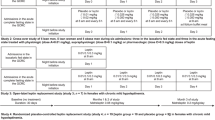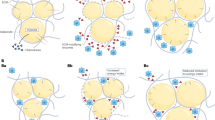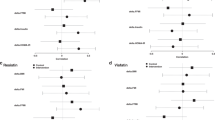Abstract
OBJECTIVES: To investigate how circulating leptin concentrations are related to regional fat distribution and whether moderate weight loss alters these relationships.
DESIGN: A 6 month, clinical weight reduction trial with measurements before and after weight loss.
SUBJECTS: 38 healthy, obese women (age: 44.3±9.9 y, BMI: 34.0±4.0 kg/m2).
MEASUREMENTS: The following measurements were made. 1. indices of obesity and fat distribution: weight, body mass index (BMI), hip circumference (peripheral fat), waist circumference, total body fat (bioelectrical impedance), abdominal fat distribution: visceral fat and abdominal subcutaneous fat (ultrasonography); and 2. Biochemical measurements: plasma leptin and serum insulin.
RESULTS: Baseline plasma leptin concentrations were three-fold higher in obese women than in normal weight controls. After weight loss averaging 8.4 kg (9.0 %), plasma leptin decreased by a mean of 22.3 % (P<0.001), corresponding to body fat decrease of 16.6% (P<0.001), abdominal subcutaneous fat decrease of 17.4% (P<0.001) and visceral fat decrease of 18.7% (P<0.001). The total amount of body fat correlated with plasma (serum) leptin before (r=0.64, P<0.001) and after (r=0.75, P<0.001) weight loss. Plasma leptin concentrations expressed per kg of body fat did not change significantly during weight loss. After controlling for body fat, baseline leptin concentrations were significantly associated with hip circumference (r=0.57, P<0.001) but not with any indices of abdominal fat distribution. After weight loss the associations became significant for hip and waist circumference as well as for visceral and abdominal subcutaneous fat. Changes in leptin correlated with changes in all indices of obesity except visceral fat.
CONCLUSIONS: Plasma leptin concentrations reflect not only total fat mass but also adipose tissue distribution, especially peripheral fat. Plasma leptin values per kilogram of fat mass do not change significantly with modest weight loss.
This is a preview of subscription content, access via your institution
Access options
Subscribe to this journal
Receive 12 print issues and online access
$259.00 per year
only $21.58 per issue
Buy this article
- Purchase on Springer Link
- Instant access to full article PDF
Prices may be subject to local taxes which are calculated during checkout
Similar content being viewed by others
Author information
Authors and Affiliations
Corresponding author
Rights and permissions
About this article
Cite this article
Rissanen, P., Mäkimattila, S., Vehmas, T. et al. Effect of weight loss and regional fat distribution on plasma leptin concentration in obese women. Int J Obes 23, 645–649 (1999). https://doi.org/10.1038/sj.ijo.0800896
Received:
Revised:
Accepted:
Published:
Issue Date:
DOI: https://doi.org/10.1038/sj.ijo.0800896
Keywords
This article is cited by
-
Recent advances and future avenues in understanding the role of adipose tissue cross talk in mediating skeletal muscle mass and function with ageing
GeroScience (2021)
-
Nonlinear relationship between waist to hip ratio, weight and strength in elders: is gender the key?
Biogerontology (2015)
-
The Use of Green Leaf Membranes to Promote Appetite Control, Suppress Hedonic Hunger and Loose Body Weight
Plant Foods for Human Nutrition (2015)
-
Body fat and body weight reduction following hypothalamic deep brain stimulation in monkeys: an intraventricular approach
International Journal of Obesity (2012)
-
Gluteofemoral body fat as a determinant of metabolic health
International Journal of Obesity (2010)



